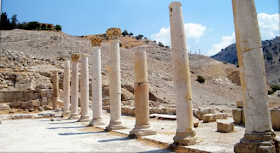Pella (Ancient Greek: Πέλλα, Hebrew: פחל) is found in northwestern Jordan, at the modern town of Tabaqat Fahl, طبقة فحل) 27.4 km south of the Sea of Galilee. Pella represents one of about ten cities of Decapolis, which were founded during the Hellenistic period and became powerful under Roman jurisdiction. With a history extending back into the Bronze Age, Pella expanded to its largest state during the Roman period. It is located in the Jordan Valley, 130 km north of Amman. Today, the city's ancient sites are excavated by archaeologists, and attract thousands of tourists annually.
Established as an urban centre under the early Seleucids, its ancient name must still have been known, for its new, Greek name was a close synonym, Pella - the birthplace of Alexander the Great in the area of Macedonia in Greece.
Several of these houses suffered what appears to be the same fiery destruction in the Late Hellenistic period. This has been attributed to a massive destruction by the Hasmonean king, Alexander Jannaeus, about 83 or 82 BCE (Josephus, The Jewish War 14.4.8; Antiquities 14.4.4). From Josephus, it is clear that Pella had been damaged and therefore needed some restoration by Pompey decades afterwards; but his specific reference to the destruction of Pella by Jannaeus because its inhabitants refusing to follow Jewish customs, seems to refer to a different place (Antiquities, XIII.395-397): it is listed as if amongst southern Levantine cities and out of its more normal sequence between Gadara, Gerasa and Scythopolis.
In 63 BCE, the Roman General Pompey integrated the region into the Eastern portion of the Roman Empire, converting the old Seleucid empire into the province of Coele-Syria and incorporating Judaea as a client kingdom. A group of cities claiming Greek Hellenistic foundations asked Pompey for freedom from the threat of incorporation within Rome's new client-state of Hasmonaean Judaea. Pompey agreed, and these cities were called the Decapolis - literally, the ten cities - although the lists which have survived vary in composition and number. Pella, however, is consistently a "Decapolis" city, and the city in the northernmost bounds of the region known as Perea. If these cities had previously dated their years from their foundation under Alexander the Great or Seleucis I Nicator, they now honoured Pompey by counting 63 BCΕ as a new "Year One". Like most cities within the empire, Pella would have had its own town council. It also minted coins in the Roman period.
Source: Wikipedia




No comments:
Post a Comment